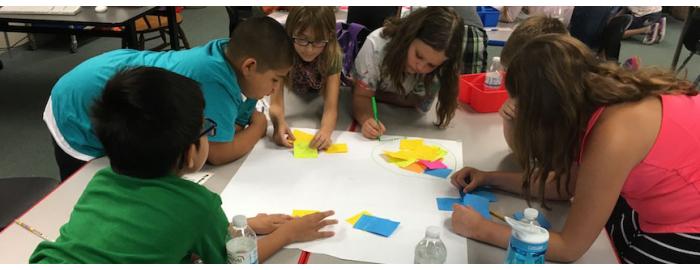
If school is about helping students understand the world around them, it makes a great deal of sense to start the school year helping students better understand themselves as friends, learners, teachers, and leaders. With this in mind, ESAA teachers Rachel Pekarek and Jamie Faul created a school wide plan to build community during the first weeks of school. We began the year using this plan to provide students and teachers with the time and space to make connections not only in their classrooms, but throughout the school and in the community. The following are some highlights from our first two days of school.
On the first day, students utilized a Yarn Toss to make peer connections expressing their interests and experiences they had over the summer. With all students sitting in a circle, one student started the process by sharing their interests or activities while holding a ball of yarn. As other students found connections to the student's sharing, they eagerly raised their hand. The student with the ball of yarn then threw it to another student while holding on to his end of the yarn and the new student shared the connection and other interests or things they did. This continued until all students shared their connections and interests. Commonalities were extensive, including experiences such camping, hiking, swimming, and playing video games. Connecting interests and experiences instantly gave students a sense of belonging. The yarn web created not only served as a visual reminder of the connections, but also provided an opportunity for classes to discuss the importance of working together toward a common goal; how one person pulling too hard on the yarn or letting go would impact the others.
During the second day of school, students shared their hopes and dreams for the school year with their classmates. These hopes and dreams — or goals — provided a starting place to help students reflect on who they are as learners and what they need in order to learn best. Thinking routines such as a Color, Symbol, Image, where students choose a color, and create a symbol and an image to represent themselves and share their thinking behind their choices, were also used to help students better understand themselves and make connections with other students.
Building on their hopes and dreams, students started to think about the classroom culture and environment in which they want to learn. Using Post-It Notes students shared their thinking on what they needed to help them learn best. Discussions were sparked. Connections were found. Common threads such as respect, kindness, perseverance, and collaboration emerged. Students voted to form consensus around the expectations of what they needed as learners in their classrooms. Student voice in establishing classroom expectations and culture helps all students take ownership in their learning. I look forward to continuing this process with students to create expectations for the common areas such as the lunchroom, bathrooms, busses, hallways, and playground.
Moving beyond the classrooms to the whole school, lower primary and upper primary classes were paired to create buddy classes. As students were introduced to their buddies, there were instant connections. Older students took the youngers’ hands and gently led them, as if they remembered their first days of school and instinctively knew the importance of human connection and feeling safe and cared for. They talked about common interests and began forming relationships as they participated in a scavenger hunt on the school grounds. Looking closely, they observed and made note of the beauty of the world around them, both manmade and natural. Throughout the year, these interactions will continue to build multiage bonds as buddy classes meet weekly to read, create, learn, and play.
Community building experiences will continue in the coming weeks as students work together to create a school wide project utilizing the creative process. On Tuesday, students will find inspiration in the discovery and research phase of the creative process, as buddy classes clean up school woods, and also go to the John Michael Kohler Arts Center. While at JMKAC, students will view the work of artist Emmy Lingscheit and participate in a thinking routine.
The interactions and connections that have been made in the first days of school will help ensure a culture where sharing ideas and taking risks in learning is welcomed and safe. This focus on developing community reminds us that we all have value — as friends, learners, teachers, and leaders — in our schools, to our communities, and throughout our lives.

